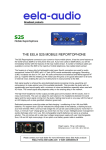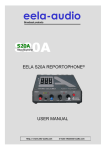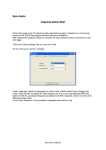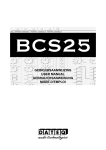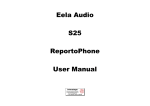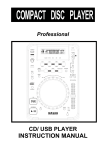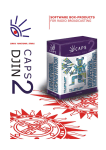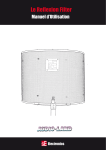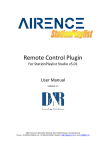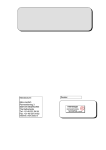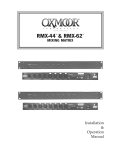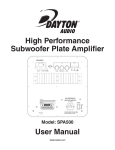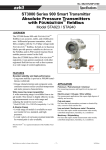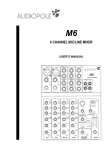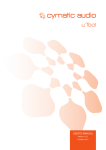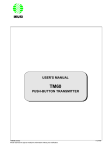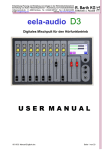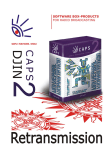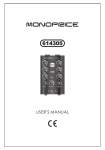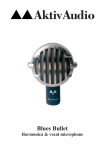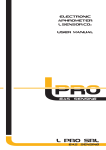Download EELA AUDIO SBM90 USER MANUAL
Transcript
EELA AUDIO SBM90 USER MANUAL EELA AUDIO SBM 90 RADIO CONSOLE The EELA AUDIO SBM90 RADIO CONSOLE is a further development of our SBM local radio mixer. It has become a multifunction unit with extended facilities, to be used by journalists and engineers for a variety of tasks. UMC UNIVERSAL MACHINE CONNECTION For the S92 and S92/E stereo line inputs. This is a combined input/output connection on a 25 pin sub D connector, allowing any kind of line level source to be connected to the console with full function remote control and signalling. Audio signals and logic available on the UMC multipin are: - 2 balanced linelevel inputs. - 2 outputs from main desk outputs for recording. - Remote control and signalization of the CUE/ PFL system. - Interface to a TAPETIMER, used with the PLAY LAMP output from the machine. - Relay isolated FADERSTART contact, with a selection of a continuous or pulsed output. - Isolated pushbutton start output. - Fader INHIBIT input, coupled to the RECORD LAMP output of the machine to prevent return signals from a machine that is recording to enter the mix, when the fader of that channel is opened by accident. For some sources line tuners, CD players etc. a simple cable is enough. More complicated functions need an adapter box with switches and circuitry in it, tailored to the type of machine. CUE/PFL system. On each input module there is a momentary pushbutton to select CUE on or off with an adjacent LED indicator. The CUE function is different for different types of inputs. STEREO INPUTS Have connections on the UMC for remote control and indication of the CUE system to give the possibility to listen to machines while standing at the machine position. This change over the monitoring can be useful when cueing machines or for selecting the monitoring before or after tape when recording or editing. The CUE signal appears on the small CUE speaker when AUTO CUE is OFF and mixes than with other selected sources. When AUTO CUE is ON on the controlroom monitor module the CUE signal appears on the main monitor speakers and a change over circuit is active to select only one source with resetting of previously selected ones. This is in fact the implementation of a separate monitor selector in the channels and is possible because the console has all sources continuously connected to the inputs, a philosophy of the radio self op desk. EELA Audio Horn 6, 5443 MA HAPS The Netherlands page 1 EELA AUDIO SBM90 USER MANUAL MICROPHONE INPUTS Also have the pushbutton and LED for CUE. When the channel is set for a microphone in the controlroom, the CUE is disabled to prevent howl round. When the source is a microphone in a studio or booth, CUE can be activated in two ways: Depressing the CUE switch lights the LED and brings the prefader signal to the CUE speaker when the fader is closed. This is an easy way of communication with (one or more) participants in that room. The difference in sound is an easy indication whether the microphone is in the mix or not, while the contact with the studio is always there. A second way to engage CUE is using the COUGH input. Closing a remote contact MUTE the fader (without influence on signalization etc.) and brings the prefader signal to the CUE speaker. This (double) function is a way of muting the channel by the presenter and opening a communication circuit with the control room. This COUGH/ COMMAND circuit is only active when the microphone is selected in STUDIO. When the AUTO CUE is ON the destination of the signal is the main monitor circuit instead of the small speaker. TELEPHONE MODULES Also have the pushbutton and LED for CUE. When the ON switch is out, which means the channel is not connected to a telephone circuit; the CUE controls are not active to prevent loss of signal when by accident the CUE of a muted telephone-channel is activated. The CUE here is mainly used for communication with a caller with the channel fader closed by listening via the CUE speaker and talking via the adjacent COMM button. Depressing the COMM mutes the CUE speaker to prevent howl round, so a push to talk intercom is realised. When the fader opens both talk- and listen functions are disabled to prevent communication to enter the program mix. MASTER MODULE S96 This combined scriptspace/master module houses the following circuits: - Mix amps for left and right main mix. These are followed by line amps to drive the OUTPUTS on the CINCH panel and the UMC connectors in the line inputs. These outputs are always in STEREO. - Two line amps for driving the MAIN OUTPUTS. These outputs can be selected mono or stereo via a jumper. The line amps feed the transmitter line via transformers and a optional ON AIR RELAY. Also the side chain for the LIMITER and the DESK selection of the monitor switch banks is connected here, so in case of a mono transmission the limiter and monitoring are also in mono. A third feed from the mixes is a separate derived MONO output, available both balanced for external feeds and unbalanced for mono recording and internal use. - A mix and line amp for then AUX OUTPUT, using the postfader AUX sends on the modules. This output can be used for selective foldback or as effect send in a production or ON AIR environment. This output is also available balanced and unbalanced. - Two OFF AIR inputs are located here as source for the monitor selectors for control room and studio. EELA Audio Horn 6, 5443 MA HAPS The Netherlands page 2 EELA AUDIO SBM90 USER MANUAL CONTROL ROOM MONITOR S97 This module feeds the main monitor loudspeakers, headphones and (optional) a meter and includes a signalling circuit for e.g. red lights. Input selection is possible for DESK OUTPUT, OFF AIR and EXTERNAL INPUTS by means of interlocking pushbuttons. When AUTO CUE is ON this selection is replaced by the (stereo) CUE signal when one or more channel CUE's are active. This change over is indicated by an LED. The output from this electronic switch is available at nominal level for driving an optional MONITOR METER. From here the loudspeaker output is driven via a rotary level control and an electronic MUTE SWITCH, activated by microphone channels assigned to control room and a DIM SWITCH, active by operating all talkback buttons. Also a headphone output is available here, with an individual level control, without MUTE and DIM. A separate MONO CUE output is derived off the stereo CUE mix for feeding the small console CUE speaker through a MUTE switch. A SIGNALLING output follows the MUTE action and has a closing isolated relay contact. STUDIO MONITOR S98 This module is necessary for foldback and signalling when a studio or booth is used. The system has two circuits, one for the guests, using loudspeakers and one for a presenter using headphones. Two situations require different foldback signals and communication. When microphones in the studio are closed, both speakers and headphones receive a signal from the source selector, being DESK, AIR or EXTERNAL. This can be overridden by talkback, while dimming the selection. Talking to studio then is talking to both presenter and guests, talking to presenter is to headphone only. When one or more microphones are open, the loudspeaker foldback is replaced with a mix of all postfader signals except the studio microphones to enable the guests to follow the program without the risk for howl round. The level can be controlled by a front panel pot and an internal trimpot to set the ratio of both signals. Talkback is no longer possible, except to the presenters headphones. The signal for the presenter is the output from the selector, independent of the microphone status. Also an isolated relay output for signalling is available, following the status of the microphone faders. EELA Audio Horn 6, 5443 MA HAPS The Netherlands page 3



